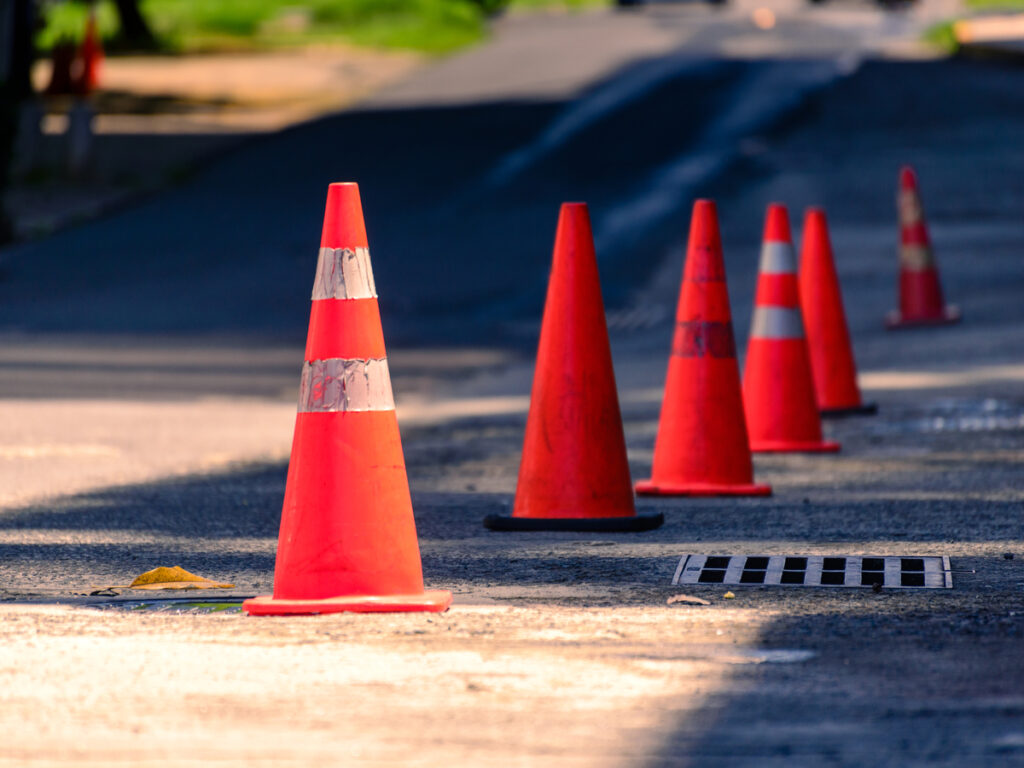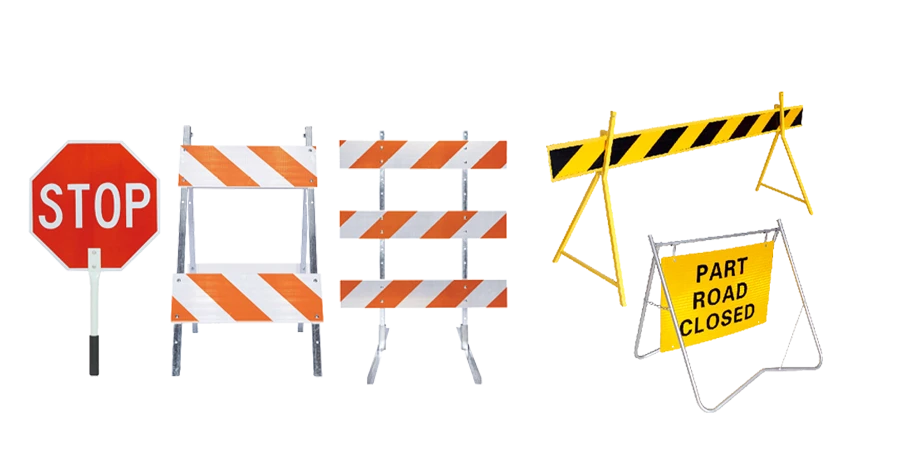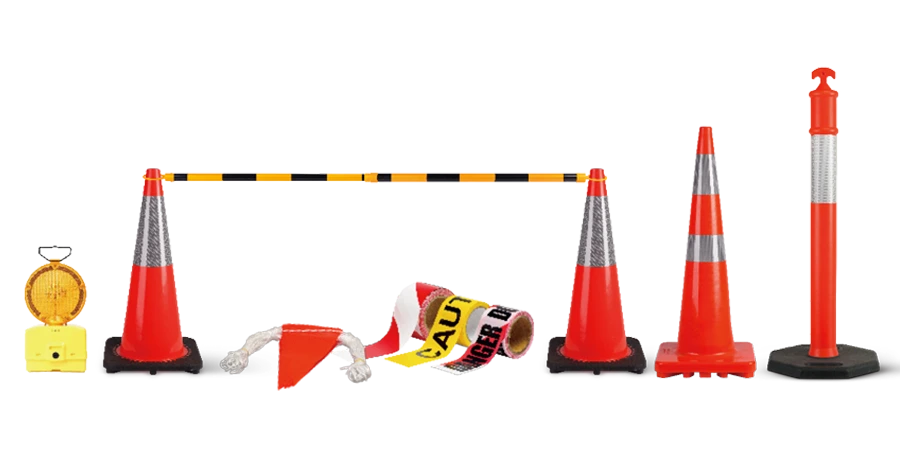
Traffic cones are essential for maintaining road safety and preventing accidents. They assist drivers, indicate temporary traffic zones, and mark work areas. High-quality cones eliminate confusion and enhance safety for both pedestrians and vehicles. Traffic cone manufacturers prioritize quality control to comply with safety regulations and deliver reliable tools for road markings and signage. By adhering to stringent standards in the production of cones, these manufacturers ensure that the cones perform effectively for temporary traffic control.
Traffic cone manufacturers, like OPTRAFFIC, take these safety regulations seriously, offering a range of high-performance traffic safety cones specifically designed for optimal visibility and durability. OPTRAFFIC ensures that their traffic safety cones for sale are built to withstand various environmental conditions, making them ideal for use in construction zones, event management, and traffic control. Their products feature reflective materials, sturdy bases, and easy-to-spot colors, providing clear guidance for drivers and enhancing overall road safety. With their commitment to quality, OPTRAFFIC plays a crucial role in maintaining safe and effective traffic control in temporary and high-traffic areas.
Key Takeaways
- Good traffic cones are made from tough materials like PVC and rubber. This helps them last through bad weather and heavy use.
- Being easy to see is important. Bright colors and shiny materials make cones noticeable, especially at night, to keep roads safe.
- Makers follow strict rules and test cones carefully. This ensures they are strong and easy to see, meeting safety standards.
- Using machines and human checks together improves quality. This helps find big and small problems in the cones.
- Making cones in large amounts lowers costs and keeps quality steady. This makes strong and reliable cones cheaper for buyers.
Characteristics of High-Quality Traffic Cones
Strong and Weather-Resistant
Good traffic cones are made to handle tough weather. Traffic cone manufacturers use strong materials like PVC and rubber to keep them sturdy. These materials stop cones from cracking, bending, or fading in heat or sunlight. Even when cars run over them or they’re used a lot, they stay in shape and work well.
Cones also need to resist rain, wind, and sunlight. Strong cones won’t blow away in wind or break down in wet weather. This makes them useful for many jobs, like marking roads or construction areas.
Easy to See and Reflective
Being easy to see is very important for traffic cones. Bright colors like orange or yellow help them stand out. This makes sure drivers and walkers notice them quickly. How well they can be seen depends on their size, color, and brightness. Reflective materials make them even easier to spot at night or in the dark.
Reflective stripes on safety cones help drivers see them from far away. Different types of reflective materials, like diamond grade, make them brighter and last longer. These features help cones stay visible at night or in dim places, keeping roads safer. Placing cones in the right spots also helps drivers see them in time to change direction.
Following Safety Rules
Traffic cones must follow strict safety rules to work well. These rules say how tall, heavy, and reflective cones should be. Following these rules makes sure cones work the same in all traffic areas.
Traffic cone manufacturers test cones carefully to check if they meet these rules. For example, they test cones to see if they’re stable, bright, and strong. Passing these tests keeps roads safe and helps people trust the cones. By following safety rules, makers ensure their cones are good for traffic control and marking work areas.
Quality Control Methods in Traffic Cone Manufacturing

Testing Materials for Strength and Flexibility
Traffic cone makers test materials to ensure they are strong. PVC and rubber go through tough tests to check reliability. These tests mimic real-life conditions like heat and car impacts. This helps cones stay sturdy and useful even with heavy use.
Flexibility is also very important for traffic cones. Cones should bend but not break under pressure. Tests also check if materials can handle sunlight and rain. This ensures cones work well on roads and in work zones, no matter the weather.
Using Machines for Accuracy and Quality
Machines help make traffic cones with perfect size and shape. Automation reduces mistakes and keeps cones consistent and safe. For example, machines ensure cones meet rules for height, weight, and brightness.
Here’s how automation improves production:
| Feature | Benefit |
|---|---|
| Accuracy | Machines make sure cones are the right size and shape. |
| Fewer Mistakes | Automation lowers errors, making cones more reliable. |
| Meeting Safety Rules | Machines help cones follow safety standards for visibility and strength. |
Automation also speeds up production while keeping quality high. This helps traffic cone manufacturers make enough cones for everyone while ensuring safety.
Following Rules for Safety
Manufacturers follow strict rules to make safe traffic cones. They test cones during and after production to check size, weight, and brightness.
Keeping colors the same is also very important. Tools like the CIELAB system give numbers to colors for accuracy. This helps reduce waste and fix problems quickly.
| Evidence Type | Benefit |
|---|---|
| CIELAB System | Numbers help check colors and keep them consistent. |
| Waste Analysis | Tools help find and fix problems, reducing wasted materials. |
| Batch Comparison | Comparing batches ensures cones match safety standards. |
By following these rules, road cone manufacturers make cones that are safe and reliable. This builds trust and shows how important cones are for road safety.
Inspection Steps for Finished Cones
Inspection steps are important to make sure traffic cones are high-quality and reliable. After making the cones, manufacturers check them to see if they are ready for real-world use. These checks look for problems, confirm safety rules are followed, and test how strong the cones are.
Checking for Surface Problems
The first step is looking closely at the cones. Inspectors search for cracks, scratches, or rough spots on the surface. These problems can make the cones weaker and not last as long. Finding these issues early stops bad cones from being sold.
Measuring Size and Weight
Traffic safety cones need the right size and weight to work well. Special tools measure their height, base width, and weight. This makes sure the cones meet industry rules and can be used in different places. Having the same size also helps stack and move them easily.
Testing Reflective Brightness
Reflective parts are very important for cones, especially at night. During checks, traffic cone manufacturers test how bright the cones are from far away. They use strong reflective materials to make sure the cones are easy to see and last a long time. This keeps roads safer by improving visibility.
Checking Stability and Strength
Cones must stay standing in wind or small bumps. Inspectors test if cones can stay upright and handle tough conditions. They also check if cones can survive heat, cold, and being hit by cars. These tests make sure cones stay useful in hard environments.
Random Testing for Quality
To keep quality the same, traffic safety cone manufacturers test random cones from each batch. These cones go through tough checks to make sure the whole batch is good. This way, even if every cone isn’t tested, the batch still meets the standards.
Tip: Using machines and human inspectors together makes checks better. Machines find measurable problems fast, while people spot small issues that need experience to notice.
By following these inspection steps, manufacturers make sure their traffic cones are strong and safe. These checks help every cone do its job in keeping roads and traffic safe.
Real-Time Monitoring in Quality Assurance
Advanced Sensors for Real-Time Defect Detection
Traffic cone makers use smart sensors to check quality instantly. These sensors find problems during production, making sure cones are safe and strong. By spotting issues early, they fix them before cones are finished.
Smart tools, like IoT sensors, help in this process. For example, some cones have sensors to track traffic and send updates. This makes roads safer by giving live data for better decisions. Edge AI systems also use this data to change signals, cutting traffic jams and improving flow.
Cities such as Los Angeles and Singapore use these technologies for better traffic control. These systems predict jams and adjust lights, saving travel time by 20%. These examples show how real-time checks improve both cone-making and traffic management.
Benefits of Automated Inspection Systems
Automated systems make cone checks faster and more accurate. They use cameras and sensors to find flaws, ensuring cones meet strict rules. Automation reduces mistakes that happen with manual checks.
These systems measure things like height, weight, and brightness very precisely. This ensures cones work well in all conditions, like marking roads or guiding cars in work zones.
Automation also speeds up making cones without lowering quality. By cutting human errors, manufacturers create reliable cones that follow industry rules. This builds trust with users who depend on cones for safety and traffic control.
Note: Automated systems handle repetitive tasks, letting inspectors focus on tricky problems that need skill and experience.
Combining Human and Machine Inspection
How Machines Help in Quality Checks
Machines are very helpful for checking traffic cone quality. They use cameras and sensors to find problems quickly and accurately. These tools measure important things like height, weight, and brightness during production. By using machines, mistakes are reduced, and cones stay consistent in quality.
Studies show how well machines work for quality checks. For example, models like Inception V3 and InceptionV2ResNet are great at spotting defects. The table below shows their abilities:
| Model | Accuracy | AUC | Details |
|---|---|---|---|
| Inception V3 | 0.9998 | 0.9999 | Very accurate, uses special settings for better results. |
| InceptionV2ResNet | 0.997 | 0.9999 | Combines features of Inception and ResNet, works well on small devices. |
| ResNet 50 | N/A | N/A | Has deeper layers, smaller size compared to older models. |
| VGG16 | N/A | N/A | Basic model, less effective than Inception models. |
| VGG19 | N/A | N/A | Similar to VGG16 but with more layers, not as efficient. |
These systems help make sure cones meet safety rules and avoid delays caused by bad products.
Why Humans Are Still Needed
Machines are great for finding big problems, but humans are needed for small ones. Scratches or rough spots on cones are easier for people to notice. Inspectors also check if reflective parts are lined up and if cones look good and work well.
Human checks add extra safety that machines can’t provide. For example, inspectors can feel the cone’s surface or spot tiny color issues that might affect visibility. This ensures cones meet both technical and real-world needs.
Using Both Machines and Humans
Using machines and humans together makes quality checks stronger. Machines handle fast and repeated tasks, while humans focus on small details. This teamwork helps cones stay reliable by fixing both big and small problems.
Data shows this method works well. The table below explains the benefits of mixing technology with human skills:
| Benefit | Details |
|---|---|
| Better Visibility | Reflective parts make cones easier to see in the dark. |
| Real-Time Tracking | RFID tags help track cones and prevent theft. |
| Saves Money | Fewer lost cones and faster updates lower costs. |
| Meets Safety Rules | Reflective cones follow safety standards. |
| Builds Customer Trust | High-quality cones show customers the company cares about safety. |
By combining the strengths of machines and humans, traffic cone manufacturers make sure traffic safety cones are safe and reliable. This method improves quality and earns trust from people who rely on cones for road safety.
Benefits of Large-Scale Manufacturing for Traffic Cone Manufacturers

Saving Money and Improving Processes
Making traffic cones in large amounts helps save money. Producing many cones at once lowers the cost of each cone. This happens by using materials wisely and wasting less. Machines make production faster and keep quality high. Standard steps also reduce mistakes, saving time and money.
Making cones in bulk lets companies offer better prices. Big orders may come with discounts or free shipping, saving clients more money. Using strong materials means cones last longer, needing fewer replacements. These savings help both makers and buyers, making good cones affordable.
By producing traffic cones in bulk, companies can significantly reduce their overall costs. OPTRAFFIC understands this principle and takes it a step further by offering tailored solutions that enhance production efficiency while maintaining high-quality standards. With a focus on large-scale manufacturing, OPTRAFFIC ensures that both the cost of materials and production time are optimized, helping businesses save money on each unit.
Additionally, OPTRAFFIC’s bulk order discounts and cost-effective shipping options provide even more savings for customers. Their durable, long-lasting cones reduce the need for frequent replacements, ensuring that customers get more value out of their purchases. This commitment to quality and savings means that businesses and organizations can rely on OPTRAFFIC for all their traffic cone needs, knowing they’re making a smart investment.
Keeping Products the Same
Large-scale production makes sure all cones are made the same way. Machines and standard steps keep cones the same size, weight, and brightness. This is important for safety because cones must meet rules and work well in all conditions.
Checks during and after production make cones more reliable. Testing materials and finished cones ensures they follow safety rules. This builds trust with buyers and shows how important quality is for traffic tools.
Adjusting to Market Needs
Making traffic safety cones on a large scale helps companies meet demand. If more cones are needed, manufacturers can make more without losing quality. This keeps a steady supply for roads, construction, and other traffic needs.
Meeting demand also improves a company’s reputation. Clients depend on getting cones on time. Large-scale production helps companies deliver quickly, keeping traffic systems running smoothly.
Tip: Making more cones now also helps companies grow in the future.
Adherence to Industry Standards and Certifications
Key Standards for Traffic Cones
Traffic cone manufacturers must follow strict rules for road safety. These rules ensure cones are strong, easy to see, and work well in different places. Two important certifications show the focus on quality and safety:
- ISO 9001: This checks that manufacturers make cones meeting global quality rules.
- OSHA Compliance: This ensures cones and other safety tools meet workplace safety needs. It reduces risks and makes cones more reliable in dangerous areas.
By following these rules, traffic cone manufacturers prove they care about making safe and high-quality cones for roads and work zones.
Ensuring Compliance Through Testing and Certification
Testing is very important to make sure cones meet safety rules. Makers test cones to check their strength, visibility, and stability. These tests copy real-life situations like bad weather or car hits to see if cones stay useful.
Certifications also confirm cones meet safety standards. For example:
- Makers check cones meet contract rules for temporary traffic control.
- They ensure cones on safety lists meet all needed details.
- Forms like TR-0030 confirm cones follow safety laws.
- Reflective parts on cones for night use must match in type and brand.
These steps make sure cones are safe and meet all rules. By focusing on testing and certifications, makers show their cones are trustworthy and reliable.
Building Trust Through Quality Assurance
Quality checks are key to earning trust from customers. By following strict rules and testing cones carefully, makers show they are serious about making good products. This gives customers confidence that safety cones will work well when needed.
Keeping traffic safety cones the same quality builds trust too. When customers know all cones meet high standards, they feel safe using them for traffic and road safety. Makers who focus on quality not only meet rules but also make customers happy.
Tip: Regular quality checks help makers keep a good reputation and strong customer relationships.
By following safety rules, testing cones, and ensuring quality, traffic cone makers help make roads and work areas safer.
Real-World Examples of Effective Quality Control
Case Study: Testing Materials for Stronger Traffic Cones
A top traffic cone company started using better material tests. They checked how strong and flexible PVC and rubber were. These are the main materials used to make cones. Engineers tested them in tough conditions like heat and heavy impacts. This helped show how cones would work in real life.
One test had cars drive over cones to see if they stayed strong. Another test left cones in sunlight and rain for a long time. This checked if they faded or broke down. These tests proved the cones could handle bad weather and tough use. This made them great for marking roads and controlling traffic.
The tests didn’t just improve the cones. They also made customers trust the company more. Showing that cones worked well in hard conditions helped the company become a trusted name in traffic safety.
Example: How Automation Reduces Mistakes
Automation has changed how traffic cones are made by cutting mistakes. A big company added machines to check cone size, weight, and brightness. These machines used sensors and cameras to find problems right away.
For example, during cone molding, machines checked the size of each cone. This made sure all cones were the same. Reflective stripes were added perfectly, so they stayed visible. Automation also saved materials by spotting problems early.
Automation did more than just improve quality. It made cones faster, helping the company meet demand without lowering standards. This meant cones were always ready for road use. By using automation, the company kept quality high, cut costs, and made customers happy.
Making sure traffic cones are high-quality is very important. Good cones help avoid accidents and keep roads safe. They stay strong, are easy to see, and follow safety rules. Makers test materials, use machines, and check cones carefully to ensure they work well. These steps save lives and make people trust the cones.
Everyone involved should care about making safe cones. By keeping quality the same, makers help create safer roads and improve how traffic flows. That’s why choosing the right traffic cone manufacturers matters.
Choose OPTRAFFIC — quality you can trust, safety you can count on.
FAQ
What materials are used to make traffic cones?
Traffic cones are made from strong materials like PVC or rubber. These materials keep cones tough and flexible in bad weather. They also help cones handle hits and stay useful for road safety.
How do makers ensure traffic cones are safe?
Makers follow strict rules like ISO and OSHA standards. They test cones for size, weight, brightness, and strength. Machines and people check cones to make sure they are safe and work well.
Why is reflectivity important for traffic cones?
Reflective cones are easier to see at night or in dim light. Stripes on cones help drivers and walkers notice them from far away. This keeps roads safer by preventing accidents and guiding traffic clearly.
How does automation help make traffic cones?
Machines make cones with the right size and weight every time. They check cones for brightness and other features while being made. This makes cones faster, safer, and wastes less material.
Why are human checks important for quality?
People can find small problems that machines might miss, like scratches. They make sure cones look good and work well. Using both people and machines makes cones safer and more reliable.



















